Amritsar Attractions
Amritsar is a holy city in the state of Punjab, India and its name derives from the name of the pool around the Golden Temple (Harmandir Sahib) and means “holy pool of nectar”. It is the spiritual and cultural center of the Sikh religion, and they are rightfully very proud of the city & their very beautiful and unique Gurdwara.
Amritsar is one of the most ancient and fascinating cities of India. It is an important seat of Sikh history and culture. Being the gateway for travellers coming to India on the overland route from central Asia it soon became the centre of various commercial activities.
Amritsar has various historical and religious sites. The most famous of them all in the Golden Temple which was founded by the fourth Guru of Sikhs, Shri Guru Ramdas Ji and completed by his successor Shri Guru Arjan Dev ji. Another revered shrine is the Durgiana Temple which is dedicated to goddess Durga. The museum at Ram Bagh houses weapons dating back to Mughal times and some portraits of the ruling houses of the Punjab. The Jallianwala Bagh at Amritsar reminds the visitor of one of the most brutal massacre events in the history of India. Bullet marks and the well into which some people jumped to escape the onslaught can still be seen. Some other attractions are—the Fort Gobind Garh which was built by Maharaja Ranjit Singh and the Tarn Taran tank which is 25 kilometres south of Amritsar.
Amritsar being an important Travel & Trade centre is very well connected to other important cities of India by Air, Train and Road. The major tourist attractions in Amritsar are as follows:
Golden Temple

The Harmandir Sahib (Punjabi: ਹਰਿਮੰਦਰ ਸਾਹਿਬ) also Darbar Sahib (Punjabi: ਦਰਬਾਰ ਸਾਹਿਬ), and informally referred to as the “Golden Temple” is a prominent Sikh Gurdwara located in the city of Amritsar, Punjab, India. It was built by the fifth Sikh guru, Guru Arjan, in the 16th Century. In 1604, Guru Arjan completed the Adi Granth, the holy scripture of Sikhism, and installed it in the Gurdwara. There are four doors to get into the Harmandir Sahib, which symbolize the openness of the Sikhs towards all people and religions. The present day Gurdwara was rebuilt in 1764 by Jassa Singh Ahluwalia with the help of other Sikh Misls. In the early nineteenth century, Maharaja Ranjit Singh secured the Punjab region from outside attack and covered the upper floors of the Gurdwara with gold, which gives it its distinctive appearance and its English name.
Wagah Border
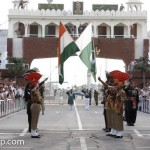
Wagha Border is located at a distance of 28 kilometers from Amritsar. The retreat ceremony during sunset is the main reason for tourists to visit the Wagah Border. Bordering India and Pakistan, armed soldiers in a parade lower the flag and close the gate. The event takes place in the evening and you can see people from both the country shouting to boost up the energy and to cheer their nation. Special buses and taxis from Amritsar take the tourists to Wagah Border. At the border outpost there is a complex of buildings, roads and barriers on both sides. At the entrance of this outpost, there is a sightseeing gate with an inscription “Swarna Jayanti”. From this a panoramic view of the landscape is seen.
Jalianwala Bagh
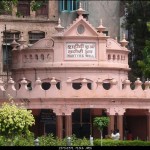
Jallianwala Bagh (Punjabi: ਜਲ੍ਹਿਆਂਵਾਲਾ ਬਾਗ਼, Hindi: जलियांवाला बाग़) is a public garden in Amritsar in the Punjab state of India, and houses a memorial of national importance, established in 1951 to commemorate the massacre by British occupying forces of peaceful celebrators on the occasion of the Punjabi New Year on April 13, 1919 in the Jallianwala Bagh Massacre. Colonial British Raj sources placed the fatalities at 379, and with 1100 wounded. Civil Surgeon Dr. Smith indicated that there were 1,526 casualties. The true figures of fatalities are unknown, but are likely to be many times higher than the official figure of 379. The 6.5-acre (26,000 m2) garden site of the massacre is located in the vicinity of Golden Temple complex, the holiest shrine of Sikhism. The memorial is managed by the Jallianwala Bagh National Memorial Trust, which was established as per the Jallianwala Bagh National Memorial Act passed by the Government of India in 1951.
Durgiana Mandir
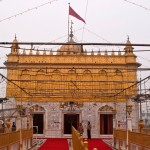
Durgiana Temple is a premier Hindu temple of Punjab (India) situated in the city of Amritsar. This temple derives its name from the Goddess Durga and it is also called by the name of Lakshmi Narayan Temple. The temple was constructed by Harsai Mal Kapoor in 1908 on the pattern of the Sikh Golden Temple and it is located near the Lohgarh gate. It is sometimes called Silver temple for its carved silver doors. The temple complex has some historic temples such as Sita Mata and Bara Hanuman.
Baba Atal Rai Tower
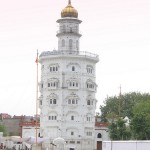
It is believed that Baba Atal Rai Ji, son of Shri Guru Hargobind Ji, breathed his last here and this has contributed to its importance. This building is nine storied attributing to his age of 9 years. The building displays high class architectural work which makes it very beautiful. It is definitely a pilgrimage spot but tourists visit the tower for a casual hangout as well.
Maharaja Ranjit Singh Panorama (Ram Bagh)
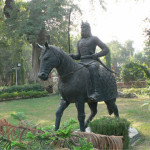
This beautiful garden is named as a tribute to Shri Guru Ram Das ji, the founder of the city. It is situated in the new part of town and has a museum in the summer palace built by the Sikh Maharaja Ranjit Singh (1780-1839) the Lion of Punjab. The museum contains weapons dating back to Mughal times and ssome portraits of the ruling houses of the Punjab and a replica of the diamond (Kohinoor). To commemorate the memory of his valour Ram Bagh has a lively statue of Maharaja Ranjit Singh saddled on a horse. It is closed on Wednesdays.
